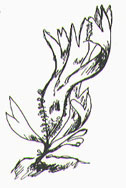![]()
|
(Palmaria Palmata) |
 Maybe
I especially like dulse because I identify with her. She's tenacious,
hardly, adaptable, and flourishes even in extreme situations. And
she has a wise woman way of changing her form to adapt to specific micro-environments.
Dulse is a wise woman, a shape-shifter, a bleeding woman, a changing woman,
a woman whose friend it is good to be. - Susun S. Weed,
Healing Wise
Maybe
I especially like dulse because I identify with her. She's tenacious,
hardly, adaptable, and flourishes even in extreme situations. And
she has a wise woman way of changing her form to adapt to specific micro-environments.
Dulse is a wise woman, a shape-shifter, a bleeding woman, a changing woman,
a woman whose friend it is good to be. - Susun S. Weed,
Healing Wise
Come April and the blood starts stirring in the Northern California seaweed wildcrafter. Now's the time for the annual Easter egg hunt for fresh, tender, red dulse. Waves surge, brilliant spring sunlight dances with sudden rain squalls. I return to the shaded nooks, the cool crevices that are home to this cool-loving sea vegetable.
Sometimes, as in the warm-sea El Nino years, there is scarcely a rust-red blade waving in the dulse crannies. Other years magnificent blooms appear, with ribbon-like fronds up to three or four feet long. With dulse, I never know when, or how much. Always it reappears in the same precise place, its rare home niche in the Mendocino intertidal zone.
Dulse seduces me, hypnotizes me with its waving red fronds. I may harvest a large load, only to take it home and find that most dries looking grey. Or a three-day rainstorm may blow up, and the dulse rots before I can get it dry. (Into the garden with it!)
Or, frequently, clouds slow the drying process. Then the dulse sweats salt, and dries looking like a frosted Christmas tree. In vain I insist to buyers that frosty dulse is perfectly good. Half-price dulse, anyone?
Occasionally, once every few years, we stash a few huge loads of deep red dulse dried quicly in the hot sun. Then we have a highly marketable product.
Dulse is the only major sea vegetable which comes into the American diet from Northern European cultures. The massive dulse beds of Grand Manan Island, in New Brunswick off the Canadian Atlantic Coast, yield tons of dulse for the world market. Maine wildcrafters sell all the dulse they can get from the rocky Maine Coast.
Here in Mendocino dulse is scarece. Confined to unusually cold locations, the best fronds are usually gone by the time the weather settles down to good drying days. There must be some big patches of dulse farther north, in Washington State up into Alaska. We could sell a lot more good North Pacific dulse than we can harvest. (North Pacific wildcrafters, do you read me?)
Dulse is deep red to reddish-brown, growing on the mid-intertidal zone. Its blade arises directly from the holdfast. The blade is deeply cleft or branched, up to a few inches wide and several feet long. Dulse may look like a flame painting in the surf, vaguely reminiscent of a waving palm; hence its species name, palmata. The shape of the blade varies with its location. I think Atlantic dulse fronds tend to be broader and shorter, while Pacific dulse often sends out long ribbons up to two inches or so wide.
Mendocino dulse grows intermingled with a dazzling array of other deep red sea vegetables. Often I have to tast it to identify it. Dulse is slightly crisper in texture than other leafy red sea vegetables. Fresh, it tastes like potato peelings. Look for dulse in low-tide tidepools and sea-filled crevices in locations shaded from morning sunlight.
Harvest dulse by pulling the longer blades from the rocks, leaving shorter blades for regeneration. Avoid grey or roughened blades. Sometimes dulse looks beautiful in the sea but dries a dead-leaf grey, so don't go crazy on harvesting a big patch you've just discovered (like I'll probably do next season!)
Spread the dulse in a mat on screens to dry. If you harvest midday, hold the crop in cool storage overnight and spread it in the morning, so it will be mostly dried by dusk, to avoid that frosted salty look. It can be flipped like a pancake mid-afternoon. If you leave it out in the dew overnight, it will fade to pinkish-white.
Dried dulse is red, somewhat leathery in texture, and intensely salty even if it has been rinsed in fresh water to remove sand. It has a distinctive "dulse" taste, and becomes mushy quickly in boiling water.
Grand Manan Island harvesters expose dried dulse to humidity for a while, softening it, making it a delicate and chewy treat from the sea that our dulse loving customers really enjoy.
P.O 455 Philo, CA 95466
(707) 895-2996
Contact Us By Email
||Price Guide||Book Order||Other Sites||Feature||Recipes||John's Journal||Family Life ||Healing Food ||
Website Created & Maintained by: seaweed.net